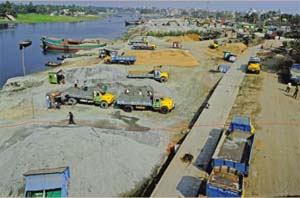Court Directives, Govt Warnings, Public Outcry
Result close to ZERO
Pinaki Roy
 Encroachment and pollution of the Buriganga, Shitalakhya, Turag and Balu rivers in and around the capital continue despite the government’s pledges to put an end to those.
Encroachment and pollution of the Buriganga, Shitalakhya, Turag and Balu rivers in and around the capital continue despite the government’s pledges to put an end to those.
In response to a campaign by the media, the government in June 2009 pledged to restore water flow in the rivers, stop pollution and encroachment, and recover the grabbed land.
In May-June that year The Daily Star ran two series of reports on encroachment and pollution of the four rivers–the lifeline for the densely populated capital–and a campaign styled “Save River, Save Dhaka”.
The pledges apart, the government is legally bound to restore the river systems, as the High Court on June 25 the same year issued a set of directives for it to stop pollution and encroachment.
The directives, which were to be implemented by different deadlines, included demarcating the river shorelines, removing the illegal structures and stopping pollution and encroachment.
The government responded positively with the prime minister making a raft of pledges to save the rivers. Even a project of around Tk 1,000 crore was initiated.
But little has changed since then.
Instead of taking proper and adequate measures to protect the rivers, the ministries concerned seem more interested in projects involving mega budgets.
The government is now going for a Tk 944 crore project to connect the Dhaka river systems with the Jamuna through the Pungli. Planned to be completed within 2013, the project will start this month.
In the first phase of the project, the Water Development Board will dredge 23 kilometres of the rivers at a cost of Tk 75 crore.
In light of the HC directives, a government taskforce on rivers suggested a number of steps, but few of those have been implemented.
Though Dhaka, Narayanganj, Gazipur and Munshiganj district administration completed surveys and demarcation of the four rivers by November 30, the government has yet to complete its drive against the grabbers.
Bangladesh Inland Water Transport Authority (BIWTA) had conducted several drives on the banks of the Buriganga, Turag and Shitalakhya, but could not recover the grabbed portions of the rivers.
Many of the encroachers have land documents that belong to the British era, though “their land” clearly falls into the rivers.
“Whenever we find reports of river-grabbing and earth-filling, we file cases. But the encroachers take legal protection from the courts showing their British-era land documents,” said BIWTA Secretary Monowar Hossain.
In a follow-up visit 20 months after publishing the river series, this correspondent found pollution not decreasing though the Department of Environment had conducted drives and fined more than 100 industrial units in last three months.
The level of pollution remains so high that Dhaka Water and Sewerage Authority (Wasa) has to treat stinky water and supply it to the households.
The four rivers still give off a horrid smell, as industries keep polluting them.
The government has done little to plug the sources of river pollution. A recent study by World Bank and the Institute of Water Modelling (IWM) shows that major effluent discharge units in Dhaka and Narayanganj continue dumping industrial and household waste into the rivers in and around the capital.
Talking to The Daily Star, Shipping Minister Shajahan Khan said they could not meet the court’s deadlines for different reasons.
However, he added, the government is putting in its best efforts to make good on the pledges.
In reality though, things appear otherwise. Not only have the influential encroachers remained untouched, new encroachers have emerged to fill up rivers, canals and other wetlands.
Even the BIWTA, the government agency entrusted with the task of maintaining the navigability of the rivers, has filled a stretch of Shitalakhya at Kanchpur and built structures for commercial purposes.
It did so ignoring repeated protests and pleas from the environmentalists.
Asked if they would knock down those structures, the shipping minister said the government would go by the court directives.
In its directives, the HC said once the demarcation is completed, the authorities concerned must have the riverbanks lined with pillars by May 30, 2010.
It also ordered that within six months after demarcation, the land ministry hand over 50 yards along the riverbanks to the BIWTA.
But the government has failed on almost all counts and has lately appealed to the court to extend the deadline by two more years.
The signs are not encouraging also with regard to the encroached city canals.
The taskforce at its eighth sitting in October last year decided to conduct eviction drives on four canals every month to gradually free 43 canals from illegal structures. But in over three months, only two have been recovered.
At the meeting in October, Sanzida Khanam, ruling Awami League lawmaker, alleged the administration evicts only the poor, while the influential grabbers remain out of reach.
Earlier on March 31, the taskforce identified 13 low bridges (some under construction) on rivers around the capital as obstacles to movement of watercraft and decided to knock those down.
But no action was taken regarding that as well.
Image (above) caption: The pavement demarcating the Gabtoli bank of the river Turag shows how the river is grabbed by sand traders. They have made sand piles well inside the river’s boundary. They continue to narrow down the river by around 100 feet from the shore even though the BIWTA conducted several drives over the years to evict the river encroachers and demolish illegal structures. Photo: Anisur Rahman
Via: The Daily Star Image credit: Anisur Rahman/The Daily Star




















